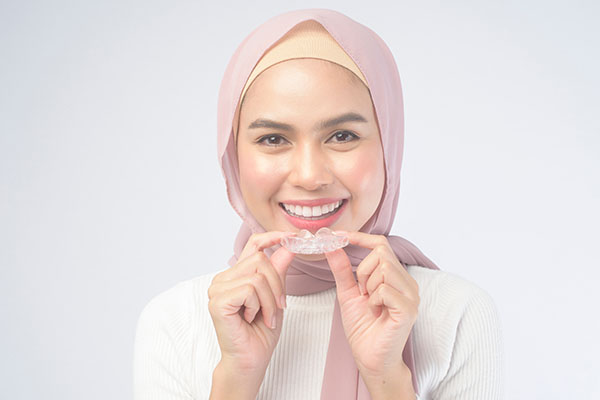 For many patients, Invisalign® treatment is a good alternative to traditional braces. Treatment time is often shorter, and patients can maintain better oral hygiene during the process. This type of orthodontic treatment uses a series of clear aligners to straighten teeth. The patient wears the trays for 20-22 hours a day, only removing them for eating and oral hygiene routines. The aligners put pressure on the teeth to move them into the correct position, and the patient changes aligner trays periodically so that movement keeps occurring.
For many patients, Invisalign® treatment is a good alternative to traditional braces. Treatment time is often shorter, and patients can maintain better oral hygiene during the process. This type of orthodontic treatment uses a series of clear aligners to straighten teeth. The patient wears the trays for 20-22 hours a day, only removing them for eating and oral hygiene routines. The aligners put pressure on the teeth to move them into the correct position, and the patient changes aligner trays periodically so that movement keeps occurring.
Guidelines for changing Invisalign® aligners
The patient changes Invisalign® trays based on the dentist's recommendation. This varies based on the patient's length of treatment and amount of orthodontic movement necessary.
Standard timeline for aligner wear
Typically, patients start by wearing aligners for two weeks at a time. After getting accustomed to wearing the trays, the patient may be able to change aligners sooner than two weeks. This depends on how quickly the teeth are moving into the right position. The patient may initially switch to 10-day changes, and if that goes well, the dentist may recommend weekly changes.
One of the main benefits of Invisalign® over regular braces is treatment time can be halved if the patient is compliant. Instead of visiting the dental professional only once a month to tighten braces, the patient can have new orthodontic movement happening every week.
When to change aligners more frequently
Many patients wonder when it is time to switch to weekly aligner changes instead of biweekly ones. While this varies in each case, there are a few signs to watch for. The aligners may start feeling loose after a few days, and the patient may not feel pressure on the teeth anymore. These are signs the patient's teeth are moving according to the treatment plan, so aligners can be changed more frequently.
Patients may also want to speed up treatment if there is a special event coming up, such as a wedding. With regular braces, altering treatment time is usually not possible. However, with Invisalign®, this is an option the patient and dentist can discuss.
What to do if trays do not fit
Sometimes, teeth do not move into the expected position on the expected timeline. When this happens, the patient may have to wear each set of aligners for a longer period of time. The dentist can check to see that the teeth are moving into position with each new Invisalign® tray, a process called tracking. If the teeth are not tracking, the tray may not fit well on the teeth. If the correct movements do not start occurring, the dentist simply requests a revision of the patient's case. In this scenario, the patient gets all-new aligners so that the process can continue to go smoothly.
Conclusion
Invisalign® is an attractive tooth-straightening treatment option for those who want to avoid traditional braces. When patients is compliant with all aspects of treatment, including aligner wear time, they can look forward to a beautiful smile.
Request an appointment or call Cumming's Family Dentist at 770-280-8723 for an appointment in our Cumming office.
Related Posts
You probably already know that Invisalign® trays look very different than traditional braces, but you may not know how ideal Invisalign is for many teens. Older teens are often very active in sports or might worry about how others think about teeth-straightening devices. The clear trays of Invisalign are less conspicuous than traditional braces. You…
For a long time, if a person wanted straighter teeth, the only option was traditional braces. However, the introduction of Invisalign® in 1999 changed that. This treatment involves a series of clear plastic aligners that are custom-made to fit the patient's teeth and gradually guide the teeth into the desired position. Many patients prefer aligners…
Invisalign® is one of several options you might be considering for straightening teeth. It is a way to correct the alignment by regularly changing the trays as the teeth move into the proper positions. While it may not be right for everybody, many people with less complex orthodontic cases have success using Invisalign. With Invisalign,…
